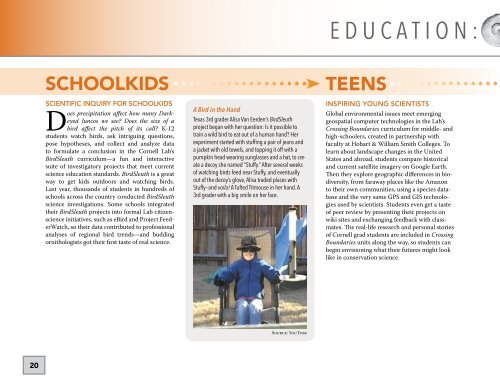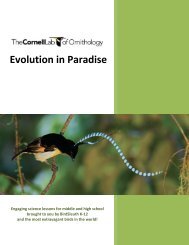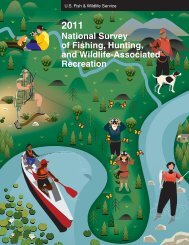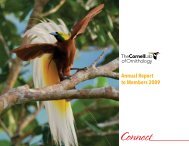Education:SchoolKidsScientific inquiry for schoolkidsDoes precipitation affect how many DarkeyedJuncos we see? Does the size <strong>of</strong> abird affect the pitch <strong>of</strong> its call? K-12students watch birds, ask intriguing questions,pose hypotheses, and collect and analyze data<strong>to</strong> formulate a conclusion in the <strong>Cornell</strong> <strong>Lab</strong>’sBirdSleuth curriculum—a fun and interactivesuite <strong>of</strong> investiga<strong>to</strong>ry projects that meet currentscience education standards. BirdSleuth is a greatway <strong>to</strong> get kids outdoors and watching birds.Last year, thousands <strong>of</strong> students in hundreds <strong>of</strong>schools across the country conducted BirdSleuthscience investigations. Some schools integratedtheir BirdSleuth projects in<strong>to</strong> formal <strong>Lab</strong> citizenscienceinitiatives, such as eBird and Project FeederWatch,so their data contributed <strong>to</strong> pr<strong>of</strong>essionalanalyses <strong>of</strong> regional bird trends—and buddingornithologists got their first taste <strong>of</strong> real science.A Bird in the HandTexas 3rd grader Alisa Van Eerden’s BirdSleuthproject began with her question: Is it possible <strong>to</strong>train a wild bird <strong>to</strong> eat out <strong>of</strong> a human hand? Herexperiment started with stuffing a pair <strong>of</strong> jeans anda jacket with old <strong>to</strong>wels, and <strong>to</strong>pping it <strong>of</strong>f with apumpkin head wearing sunglasses and a hat, <strong>to</strong> createa decoy she named “Stuffy.” After several weeks<strong>of</strong> watching birds feed near Stuffy, and eventuallyout <strong>of</strong> the decoy’s glove, Alisa traded places withStuffy—and voila! A Tufted Titmouse in her hand. A3rd grader with a big smile on her face.TeensInspiring young scientistsGlobal environmental issues meet emerginggeospatial computer technologies in the <strong>Lab</strong>’sCrossing Boundaries curriculum for middle- andhigh-schoolers, created in partnership withfaculty at Hobart & William Smith Colleges. Tolearn about landscape changes in the UnitedStates and abroad, students compare his<strong>to</strong>ricaland current satellite imagery on Google Earth.Then they explore geographic differences in biodiversity,from faraway places like the Amazon<strong>to</strong> their own communities, using a species databaseand the very same GPS and GIS technologiesused by scientists. Students even get a taste<strong>of</strong> peer review by presenting their projects onwiki sites and exchanging feedback with classmates.The real-life research and personal s<strong>to</strong>ries<strong>of</strong> <strong>Cornell</strong> grad students are included in CrossingBoundaries units along the way, so students canbegin envisioning what their futures might looklike in conservation science.Source: YouTube20
Discovering birds, connecting <strong>to</strong> natureHigher EducationMen<strong>to</strong>rship…pass it onLast year the <strong>Cornell</strong> <strong>Lab</strong> continued its proudrole as an academic research institution, with<strong>Lab</strong> scientists advising more than 100 undergradand graduate students. <strong>Cornell</strong> Ph.D. candidateNathan Senner was one <strong>of</strong> those students, with adissertation on a multiyear research project thatbanded Hudsonian Godwits with GPS data loggersin sub-arctic Mani<strong>to</strong>ba and moni<strong>to</strong>red theirextraordinary 6,000-mile flights <strong>to</strong> Ecuador andChile. Senner became the first scientist <strong>to</strong> detailthis godwit’s marathon migrations, one <strong>of</strong> theLIFELONG LEARNINGBird study for everyone<strong>Cornell</strong> <strong>Lab</strong> lifelong learning programs are basedon the premise that you don’t have <strong>to</strong> be a collegebiology major <strong>to</strong> study ornithology. In 1972 the<strong>Lab</strong> introduced “A Home Study Course in BirdBiology,” the first college-level correspondencecourse in ornithology. Four decades later, thecourse has enrolled more than 10,000 people in65 countries with a rigorous curriculum <strong>of</strong> birdbehavior, ecology, evolution, and more. Severalzoos across the nation have made it a requiredcourse for zookeepers in training. In 2013 thefarthest recorded travels <strong>of</strong> any bird on earth. Theproject also ignited the imagination <strong>of</strong> a teenagernamed Andy Johnson, who attended Senner’s godwitlecture at the <strong>Lab</strong>’s 2009 Young Birders Event.Johnson enrolled at <strong>Cornell</strong> as a biology undergradthe following year and became a field assistant forSenner, travelling with him from Churchill, Mani<strong>to</strong>ba,<strong>to</strong> Tierra del Fuego. Now Johnson is hard atwork on his thesis project studying Whimbrels,and making plans for his own research journeys <strong>to</strong>the Arctic and South America.latest edition <strong>of</strong> the course’s Handbook <strong>of</strong> BirdBiology will be published by Wiley-Blackwell asan <strong>of</strong>ficial college textbook for university ornithologycourses. Another lifelong learning coursecreated by the <strong>Lab</strong> in 2009, Courtship and Rivalryin Birds, uses interactive online learning <strong>to</strong> helpindividuals around the world develop new skillsin observing and understanding bird behavior.Enrollees so far have come from 18 countries,ranging from beginning birders <strong>to</strong> park naturalistsand wildlife pr<strong>of</strong>essionals.Hawk and Heron Reality ShowsFrom February <strong>to</strong> June <strong>2012</strong>, more than 2 millionpeople from 176 countries watched the real-lifedrama <strong>of</strong> Great Blue Herons nesting a<strong>to</strong>p a deadtree at Sapsucker Woods and Red-tailed Hawks a<strong>to</strong>pa light pole on the <strong>Cornell</strong> campus, courtesy <strong>of</strong> HDweb cams installed and operated by the <strong>Cornell</strong><strong>Lab</strong>. Viewers ranged from BirdSleuth schoolchildrenwho got an educational look at nesting biology <strong>to</strong>adults who found the daily drama—from fending <strong>of</strong>fowl attacks on the nest <strong>to</strong> a fragile fledgling’s waveringfirst flight—as gripping as General Hospital.Three more cams launched in <strong>2012</strong>, in partnershipwith other organizations, and broadcast nests fromelsewhere across the country: American Kestrelsin Idaho, Ospreys in Montana, and Pacific Loons inAlaska. Future cams may feature birds from moreexotic locations, such as rainforests in the Amazonand jungles in Southeast Asia, thus furtheringthe <strong>Lab</strong>’s goal <strong>to</strong> engage everyday people in thefascinating lives <strong>of</strong> birds.21






